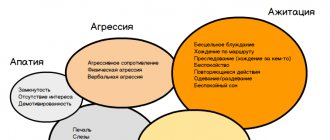Hands on hips
The aggressiveness of the interlocutor, his readiness to enter into direct conflict and showdown - this is how the language of gestures describes hands on hips. It is believed that such a pose, as it were, prepares the human body for a possible attack.
Hands behind your back
How can sign language explain the hands behind the back of a communicating person? It is believed that this pose, characteristic of members of the royal family, carries confidence and complete control over the situation, but this is only if the person stands with a straight back and head held high; otherwise, hands behind the back indicate humility and feeling of a hopeless situation.
What is kinesics
What is kinesics? This is a science that studies the role of gestures, facial expressions, body movements and other non-verbal manifestations in the process of communication. Some of the first studies of kinesics were carried out by Charles Darwin in his work on the expression of emotions in animals and humans. The concept of “kinesics” was first used by R. Birdwhistell in 1952.
Unlike speech, kinetic manifestations are not so much subject to volitional control. Often they can provide even more information than words. Gestures and facial expressions allow a person to more accurately convey to the interlocutor the meaning of what was said, express his attitude to the information, and reveal details in detail. The listening person, using non-verbal means, reads additional information, can distinguish truth from lies, and can also simply support the speaker and show his concentration on him, for example, by nodding his head or facial expressions.
Nonverbal communication what is it in psychology
Nonverbal communication is a type of communication without the use of words (through images, intonation, gestures, facial expressions). The tools for influencing a person are:
- sight;
- interpersonal space;
- optical-kinesthetic signals (facial expressions, appearance of the interlocutor, pantomime);
- peri-speech factors – vocal range, vocal qualities, timbre;
- extra-speech (laughter, speech rate, pauses).
For your information. Nonverbal methods of communication improve mutual understanding between people, allow you to predict the mood and attitude of the interlocutor towards the individual, and predict your own communication model.
Facial expressions
Facial expressions are various movements of the facial muscles and their combinations. It is quite weak to control; it is not always possible to restrain an impending smile or frowning eyebrows. With the help of facial expressions, a person can express a whole range of emotions without words: sadness, anger, joy, tenderness, surprise, delight, disappointment, bewilderment and others. More than other parts of the face, the eyebrows and mouth are involved in facial expressions.
There are people with well-developed ability to control their own facial muscles. It is sometimes not possible to correctly recognize their emotions or the veracity of information. They can enhance facial expressions or, conversely, restrain them. However, it is not always possible to completely control these processes during a conversation, so it is necessary to constantly compare the words and facial expressions of such people.
Sight

Gaze and eye contact with the interlocutor play a huge role in communication. With just your eyes you can express contempt or respect, interest in a conversation or boredom, confidence or shyness. Even the pupils can provide information about a person at a given moment. Dilated pupils often mean emotional excitement and a positive mood, while constricted pupils indicate uncertainty or a bad mood.
The frequency and duration of eye contact also matters. A self-confident person can communicate without almost taking his eyes off the interlocutor. Also, long-term eye contact is established between well-known and close people with whom you can be frank. Jerky glances, lowering the eyes to the floor or constantly looking them to the side can indicate a person’s lack of confidence in himself or in the information he is giving out. Lies, lack of emotional contact with the interlocutor and reluctance to talk are also manifested in a similar way.
Gestures
Gestures are voluntary and involuntary movements of the hands and head during communication. Gestures can say a lot about a person himself. Active movements are usually characteristic of people with an extroverted personality, with a sanguine or choleric temperament, a high level of self-confidence and good self-esteem. Individuals with an introverted personality, melancholic, phlegmatic, and insecure people usually display a rather meager range of gestures.
Movements of the head and hands also say a lot about the current state of a person. The more active the gestures, the more interested the person is in the conversation and in being heard. Very weak or absent gestures often indicate that the person is not interested in the conversation. It may also indicate an attempt to deceive the interlocutor.
Three main groups of gestures can be distinguished:
- Communicative. Used in any type of communication, they usually accompany greetings, farewells, and attempts to attract attention to oneself. Examples include shaking or waving your hand.
- Modal. With their help, a person expresses his attitude to the information spoken or heard. For example, nodding your head as a sign of approval or turning away, indicating reluctance to continue the conversation.
- Descriptive. These are gestures that have meaning in the context of the actual conversation. For example, a person uses gestures to show the size of a caught fish or uses them to describe the layout of his house under construction.
It is worth understanding that in different peoples and cultures, gestures can differ and even be opposite. For example, a simple nod of the head means agreement in some countries, and denial in others. Another example is twisting your finger at your temple. In Russia it is interpreted as stupidity, in India as a sign of respect, and in Holland as an indicator of high wit.
Common Gestures
Gestures may vary in meaning from person to person, but there are generally accepted movements that are very common in communication. These include, for example, the following manifestations:
- a person touches or scratches his ears as a sign that he does not like the information he hears;
- rubs his chin – he feels bored and lacks interest;
- strokes his chin - reflects and ponders;
- taps his fingers and constantly glances at the clock - he is in a hurry, nervous or impatient;
- crosses his arms over his chest - most likely, does not want to talk;
- rubs his neck - not sure of the information said or heard;
- puts his hands behind his head or behind his back - trying to demonstrate his superiority over his interlocutor;
- covers his mouth - he is hiding something or is not saying something, perhaps he is providing deliberately false information.
The Origin of Nonverbal Communication
Nonverbal language has two types of origin: biological evolution and culture. Biologists have found that facial expressions when expressing emotions, most gestures and body movements in people are innate and serve as a signal for feedback. The biological nature of nonverbal communication is confirmed by elements not controlled subconsciously:
- paleness or redness;
- enlarged pupils;
- curvature of the lips;
- blinking.
Based on intentional and unintentional communication, there are 3 nonverbal means of communication:
- Behavioral factors. Caused by a physiological reaction: sweating from excitement, trembling in case of cold or fear.
- Unintentional means. Associated with people's habits (scratching temples, swinging legs, biting lips).
- Communication signals. Conveys brief information about an object, event, or state.
There are also universal signals known to everyone that are characteristic of a particular culture. Vivid examples are the style of behavior, dress code, and conventional signs of greeting and farewell.
Common “body signs”
Gait

Gait is the style of movement of a person. It can say a lot about its owner. For example, a heavy gait indicates a person is overwhelmed with thoughts and is depressed. Light, “flying” - about high spirits and optimistic thinking. A person who is hunched over, with his head down and shuffling his feet often turns out to be unsure of himself, while someone who is straightened up and with his chin raised moderately high has good self-esteem and is very confident in himself.
A person with an active lifestyle and prone to taking initiative walks confidently, with long steps and moderate swinging of his arms. People who are unsure of themselves most often hide their hands in their pockets or behind their backs. A thinking person walks slowly, as if tracking his every step. People walk with their chins high and their legs straight, trying to demonstrate their superiority over others.
Pose
When communicating about the interlocutor, his body position can say a lot. This sign is also poorly controlled, since parents from childhood teach the baby to control his gestures and emotions, and pay attention to posture extremely rarely. During communication, the posture may change depending on the content of the conversation and the relationship of the interlocutors with each other.
Thus, psychologists distinguish three groups of postures:
- Open and closed. Openness is evidenced by a relaxed posture, turning the body towards the interlocutor, and open palms. About closedness - crossing legs and arms, tilting the body away from the interlocutor, interlocking fingers, constantly trying to hide the palms.
- Dependent and dominant. The dominant person tries to appear taller, hover over the interlocutor, look down on him, pat him on the back or shoulder. A dependent person lowers his head, averts his eyes, and looks from under his brows.
- Harmonious and opposing. In a harmonious conversation, the interlocutors take positions that correspond to each other. In the event of a confrontation, fists may be clenched, one shoulder is forward, the chin is raised, and the hands are placed on the sides or hips.
Nonverbal communication
Definition 2
Nonverbal communication is a system of signs and symbols that is used to convey a message and intended for its most perfect awareness, which to a certain extent does not depend on the psychological and socio-psychological properties of the individual, which has a fairly clear range of meanings and can be presented as a specific sign system.
People need non-verbal means of communication to clearly understand each other. Naturally, nonverbal manifestations relate only to oral communication. Since the external nonverbal expression of feelings and emotions performed by the body is also represented by a certain set of signs and symbols, it is often called “body language.”
Too lazy to read?
Ask a question to the experts and get an answer within 15 minutes!
Ask a Question
Nonverbal communication consists of two large groups: extralinguistic and paralinguistic means of communication.
Paralinguistic group:
- Prosody. This group is supposed to include components that complement speech. These are the timbre, strength and depth of the voice, the amount of expressiveness of articulation, stress, length and nature of pauses, etc. In other words, means of the prosodic level make it possible to impart a nuance to information by influencing the voice.
- Kinesics is a complex of body movements (gestures, facial expressions) that are used during human communication (excluding movements of the speech apparatus).
- Graphemics is a way of writing that conveys a person’s emotions and feelings. The manner of writing words and letters may change depending on the emotional background. So, say, an angry person presses his pen hard on the paper, but a thoughtful person may make mistakes and forget to complete the “hooks.”
Note 1
Paralinguistic means of communication cannot be used without reference to speech.
Extralinguistic group:
- Takeshiki is a non-verbal means of communication that is based on tangible signals transmitted by people to each other. These include kissing, hugging, patting, stroking, shaking hands and other communicative actions.
- Proxemics. Interlocutors in the process of interaction can be located at a distance or close to each other, deliberately or subconsciously exercising distance control. The method of organizing contact in space, which reflects the relationship of the interlocutors to each other, is called proxemics.
- Chronemics. Distribution of time during communication. A person may be in a hurry to get to a meeting, or he may put off the call. He can wait a long time for the interlocutor to become free, or he can reduce the contact time.
- Extralinguistics. Conveying emotions with the support of the voice, but without reference to speech. These means include dissatisfied rumbling, coughing, sighs, screams, etc.
- Sensory. Perception of the interlocutor using the senses. A person responds to the smell, the tenderness of the skin during touch and the visual perception of the interlocutor. There are also separate subgroups here. An example here would be olfactory means of communication (perception through smell) and phonation means of communication (hearing perception).
There is no need to learn non-verbal communication, as these are innate skills.







